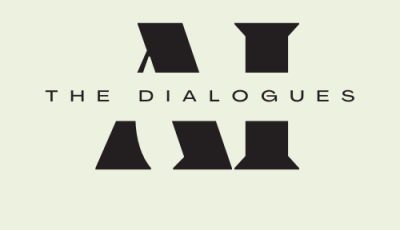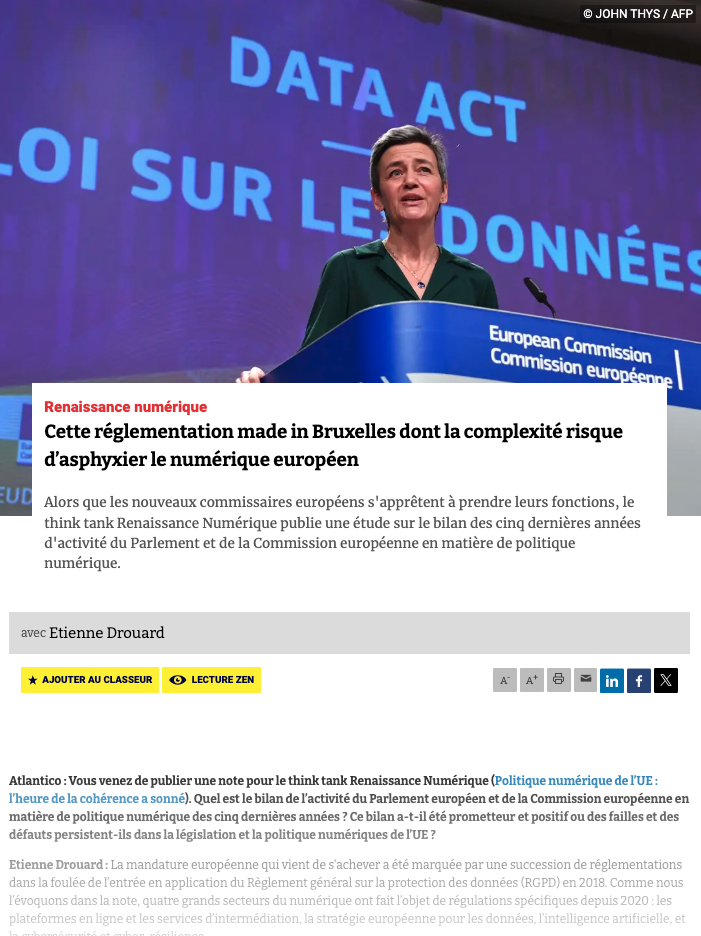Publication 2 December 2024
Review of the European term of office coming to an end with Etienne Drouard

Following the publication of the policy brief « EU Digital Policy: The Time for Coherence Has Come », Étienne Drouard, a member of the Board of Renaissance Numérique, was interviewed by the newspaper Atlantico. This was an opportunity for him to analyze the main challenges facing the new European Commissioners and MEPs in the field of digital regulation.
While the previous legislative term introduced a series of landmark texts (DMA, DSA, AI Act, etc.), their rapid adoption often lacked real coordination, creating a lack of articulation between these different regulations and jeopardizing their effectiveness. In this interview, Étienne Drouard emphasizes the importance for the new European Commission to develop procedural and interpretative texts, while ensuring effective cooperation among European regulators. This ambition is all the more strategic given the increasingly tense geopolitical situation.
What should be the priorities for the new European term in digital legislation ? Will European institutions have all the tools they need to regulate digital policy, or will there be too many obstacles ? Are tools like the GDPR, DSA, and DMA effective and sufficient ? Discover Étienne Drouard’s answers to these questions.
[Excerpt from the interview]
You have just published a policy brief for the think tank Renaissance Numérique (« EU Digital Policy : The Time for Coherence Has Come »). What is your assessment of the European Parliament and Commission’s digital policy activities over the past five years ? Has this record been promising and positive, or do flaws and shortcomings persist in the EU’s digital legislation and policy ?
Etienne Drouard : The European term that has just ended was marked by a succession of regulations following the implementation of the General Data Protection Regulation (GDPR) in 2018. As we discuss in the brief, four major digital sectors have been subject to specific regulations since 2020 : online platforms and intermediation services, the European data strategy, artificial intelligence, and cybersecurity and cyber-resilience.
For example, regarding online platforms, the Digital Markets Act (DMA), adopted in 2022, aims to combat anti-competitive practices by digital giants and correct the imbalances caused by their dominance in the European market, while strengthening the protection of online users. Meanwhile, the Digital Services Act (DSA), adopted the same year, applies the principle that what is illegal offline is illegal online. It sets out a series of rules to hold digital platforms accountable in the fight against the spread of illegal or harmful content or illegal products. The Data Governance Act, the Data Act, the AI Act, the NIS 2 Directive, and the Cyber Resilience Act complete this legislative puzzle in the other three areas.
There is no doubt that each piece of the puzzle had its own sectoral or systemic rationale. The legitimate motivations behind each text are very real. They are public, they deserve support, they are debated and arbitrated in accordance with political institutions and their core missions. From this perspective, the record may seem promising, especially since some of these texts, such as the DMA, DSA, and AI Act, were adopted in record time. But what is the use of a legislative framework if it cannot be applied, or only with difficulty, or in five years’ time ? What good is it if the actors responsible for implementing it do not know how to interpret it ? The problem is that the previous European term, in its haste, did not consider the articulation of these different texts with each other. To avoid political and institutional blockages during their development, the European Commission postponed this issue. This lack of coordination is likely to lead to numerous conflicts of competence between old and new regulators, and thus greatly limit the effectiveness of texts with otherwise commendable objectives. […]
READ THE REST OF THE INTERVIEW
-

Publication 12 November 2024
EU Digital Policy: the Time Has Come to Connect the Dots
-

Publication 25 June 2024
Is international AI governance achievable ?


